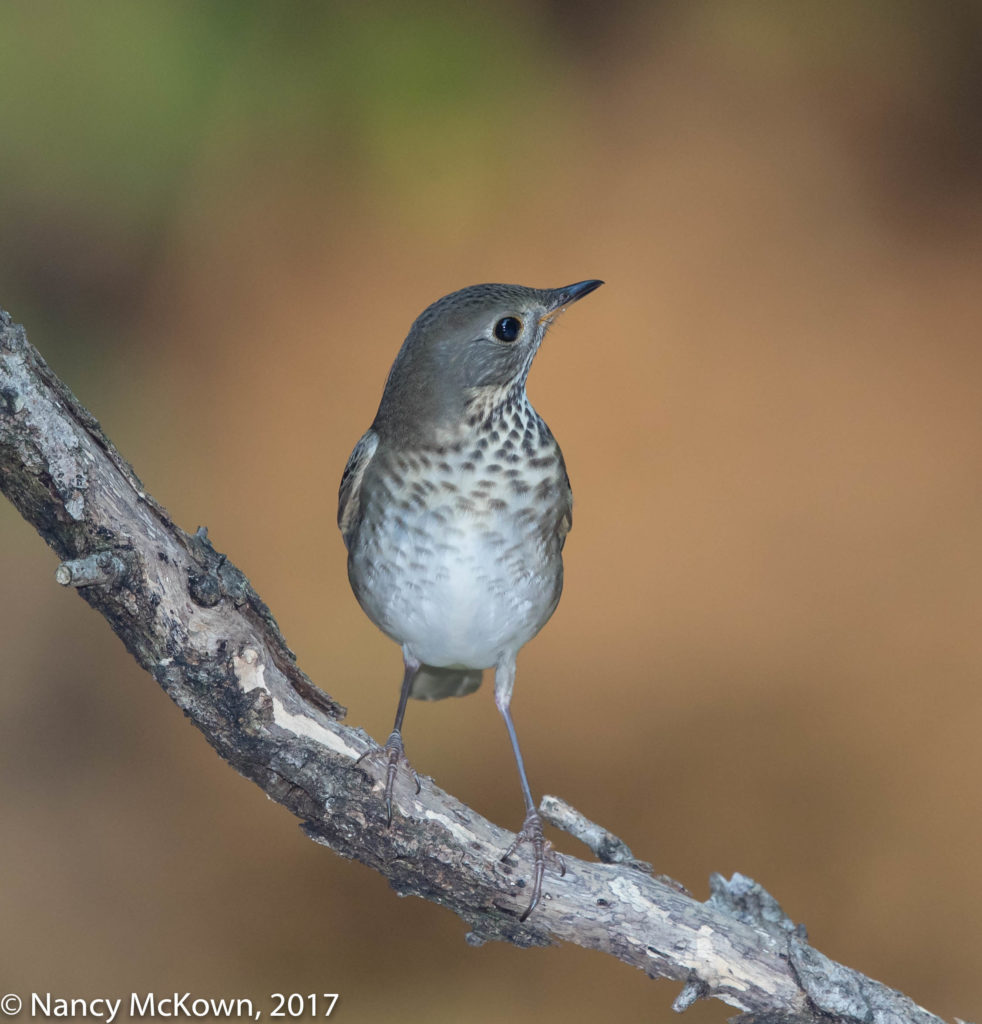Photographing a Gray Cheeked Thrush
The Gray Cheeked Thrush is a long distance migrant who travels back and forth between its remote breeding areas in Northern Canada/Alaska and South America. It is known to be shy and unobtrusive, spending a lot of time hidden in the brushy undergrowth. It’s a new bird for me. In this shot the thrush turns his head to give us a full view of its cheeky namesake.
Migrating Thrushes at the Fountain
The migrating thrushes have been dominating the fountain area lately. Swainson and Wood Thrushes arrive a little before dusk and gather in the gushing water or on the ground near to where the water dribbles down. The thrush numbers are highly variable day to day…depending on the migrating stream. For the most part, they have the fountain to themselves during the evening hours.

Acting Very Suspicious of His Surroundings.
ISO800; f/8; 1/250 Second
Noticing That A Bird is Slightly Different
With a half dozen or more birds flocking the fountain area, it often takes a while to notice if one of the thrushes is a different species. It may have similar size, shape, beak, or plumage colors, certainly enough to blend in with the other thrushes at dusk. Something usually sets the newcomer apart, like her overall comfort level, behavior, or perhaps an understated but distinguishing feature.
Some of the time, I don’t notice if a bird is different than the other birds until after it’s long gone…when I’m processing the photos the next day. Unfortunately, if I don’t notice, I’m less likely to train the lens onto that particular bird and take lots of photos. In this instance, I took one shot because I liked a radiant glow in the background…and not because I spotted a new species perched in front of that warm light.
The Quality of Image Bokeh
Our human eyes combined with a big brain see things very differently than a camera lens. Photographers don’t really see bokeh– good or bad – until they look through a camera lens and examine the out-of-focus areas of an image.
Unlike the human eye, the camera’s lens can blur the image in front of and behind its points of focus. The area of focus and the areas of blur depend on the aperture setting and the type of lens. In general, the more you open up your aperture, the thinner your area of focus and the more blur the lens delivers.
Bokeh is defined as the quality of the out-of-focus blur areas within your image. This blur – how much it enhances or diminishes the subject – has everything to do with aesthetics and feelings…quality and character. Essentially, rating the quality of bokeh is a judgement call.
Regarding Bokeh, Ask Yourself…..
- Does it have an abstract character or any attributes that enhance the subject?
- Does it give the image a more 3D quality by adding depth and dimension?
- Do the out of focus blurs meld together in a pleasing, creamy sort of way, or do background details individually appear and stand out, showing off their hard edges?
- Does the background blur accomplish what you want for your bird images, perhaps achieving what looks to be smooth isolation from the subject or telling details of a natural habitat?
What Defines Bokeh:
- Lens design…. the more precisely the aperture blades within the lens form a circle, the more likely they will intersect smoothly and minimize defined edges within the blur. (Quality, high-end professional lenses generally have 9 or more rounded blades.)
- Fast lenses…. the wider your maximum opening is, the more you can blur.
- Quality of light….harsh, overhead or insufficient lighting will cancel out a good lens any day.
- Background detail… is it mellow or crazy? What blur will it create? Can you get out there and clear unattractive background debris before the shot or possibly reposition the camera? (NOTE: It’s very difficult to reposition the bird.)
- Background color…..is the background evenly lit and full of complementary colors?
- Distance between the lens and the subject… It’s best to get as close as possible to your subject to optimize blurriness in the background.
- Distance between the subject and its background. It’s best to have the background well outside of the focus area… so individual details are not in focus and not close enough to be distinguishable.
- Long lenses (300mm+) have shallow DOF– so much so that when they are wide open, much of your intended subject may not be in focus. (See depth of field calculator for your lens.)
Talent and Luck
When an uncommon bird presents himself, there’s rarely time to consider how the blurred background will impact the overall ascetics of the image. Some bird photographers strive to capture the perfect bokeh by setting up the scene during optimal light and targeting the lens onto an ideal perch pre-positioned in what amounts to a sumptuous background. Luck has a lot to do with success in these situations. I haven’t had much luck with setups, mainly because it has been my experience that birds descend and settle whimsically, mostly alighting in all the wrong places.








